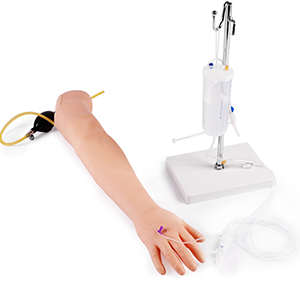

Article tag: Arterial puncture arm model| BIX-HS5| Medical teaching model|
By providing an opportunity for repeated practice, the arterial Puncture arm model helps physicians master the technique in a risk-free environment, thereby significantly enhancing their confidence in clinical practice. Whether from the perspective of personal growth, or the perspective of industry experts and data support, model training has played a cru...
Arterial puncture is one of the most important techniques in clinical care and treatment, especially in high pressure environments such as emergency departments and intensive care units, where precise operation directly affects patient safety and treatment results. As a simulation training tool, arterial puncture arm model has been widely used in medical education and clinical training. So, can the arm model of arterial puncture effectively improve the confidence of doctors? We can explore personal growth, industry expert views and relevant data.
Personal growth
For doctors, the building of operational confidence usually relies on repeated practice and familiarity with the operating process. The artery piercing arm model provides a safe, risk-free environment in which physicians can practice multiple times to master the correct piercing technique and enhance their confidence in clinical practice. Model training helps doctors overcome the tension and anxiety common to beginners and improve their fluency and accuracy. In the absence of patient risk, doctors are free to explore different operating techniques, practice for different parts of the artery puncture, and gradually improve their technical level.

Industry expert views
Industry experts generally believe that the arterial puncture arm model has a significant effect on improving the confidence of doctors. Experts point out that while clinical training is key to improving skills, doctors often face tension and uncertainty when performing the initial procedure on real patients. Through the simulation training of the arterial puncture arm model, the doctor can practice repeatedly without the pain and risk of the patient, which greatly reduces the pressure of the operation and increases the sense of control of the technique. Experts stressed that the arm model can not only help doctors familiarize themselves with the technical essentials of puncture, but also improve their resilience and self-confidence in the face of emergencies.
Data support
Relevant studies have shown that the training of arterial puncture arm model can effectively improve doctors' operational confidence and clinical skills. According to one study, doctors trained on a model of arterial puncture had a 30% increase in success in real-world Settings. In addition, a survey of emergency department physicians found that physicians trained on the arm model showed greater accuracy and fewer complication rates when performing arterial punctures, especially with a significantly increased confidence in the procedure when first contacting patients. The study also showed that through model training, doctors experienced less anxiety when facing patients, and improved fluency and reaction speed during operation.
Summary
By providing an opportunity for repeated practice, the arterial Puncture arm model helps physicians master the technique in a risk-free environment, thereby significantly enhancing their confidence in clinical practice. Whether from the perspective of personal growth, or the perspective of industry experts and data support, model training has played a crucial role in improving the confidence of doctors. With the popularization of this simulation tool, physicians can respond to arterial puncture procedures with greater confidence and precision, thereby improving patient safety and treatment outcomes.